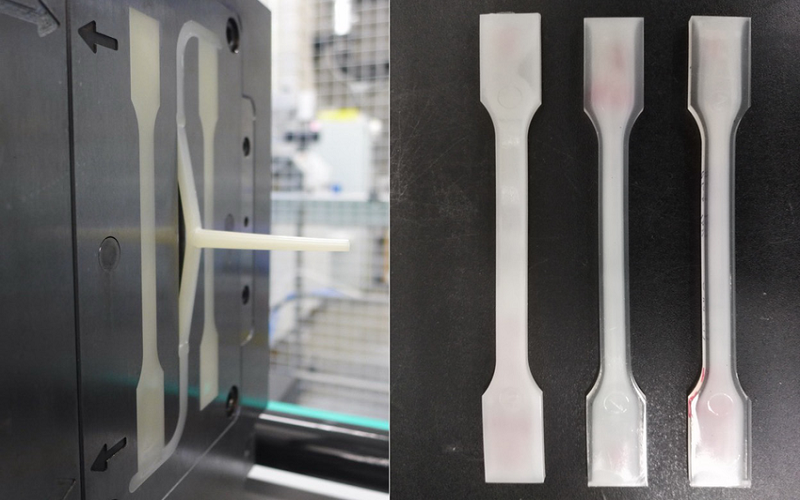In the era of sustainable development and green manufacturing, polylactic acid (PLA), as a biodegradable plastic derived from renewable resources, is increasingly becoming an ideal alternative to traditional petroleum-based plastics.
PLA injection molding technology is highly regarded for its environmental friendliness, low carbon footprint, and excellent processing performance.
This technology not only inherits the efficiency and precision of conventional injection molding but also endows products with unique biocompatibility and degradability, showing broad application prospects in packaging, medical devices, consumer goods, and other fields.
This article will delve into the characteristics of PLA injection molding, key process parameters, and practical application cases to help readers understand the technical mysteries behind this process and promote further optimization and popularization of the technology.
Characteristics Of PLA Materials
Polylactic acid (PLA) is a biodegradable thermoplastic materials derived primarily from renewable raw materials such as corn starch, sugar cane, and other starch plastic composites.
As a sustainable material, PLA offers an eco-friendly alternative to conventional plastics made from petroleum-based sources.
PLA is synthesized through the polymerization of lactic acid, a naturally occurring organic acid produced by fermenting these renewable resources.
One of the key advantages of PLA is its biodegradability; under appropriate composting conditions, PLA products can be completely degraded by microorganisms into carbon dioxide and water, minimizing environmental impact.
Moreover, PLA compounds can be modified with biodegradable thermoplastic elastomeric materials and nucleating agents to enhance their crystallization rate and mechanical properties, addressing some of the limitations related to heat resistance and brittleness.
Due to these properties, PLA is widely used in various industries for producing plastic products such as food packaging, sanitary products, floor mats, and medical components. Its compatibility with additive manufacturing and other processes further expands its application range.
In summary, PLA combines environmental sustainability with versatile processing capabilities, making it a promising material for the mass production of thermoplastic components that meet the growing demand for greener alternatives in the plastics industry.

Can PLA Plastic Be Injection Molded?
PLA exhibits unique features that make it highly suitable for injection molding and blow molding.
While PLA can function as a general-purpose resin, its injection molding process exhibits unique characteristics compared to other conventional resins, requiring specific considerations to optimize performance.
It possesses a relatively low melting point and processing temperature, typically between 170°C and 230°C, which allows for efficient melt processing and molding.
Additionally, PLA has a glass transition temperature around 55-60°C, which influences its thermal and mechanical behavior during and after molding.
Compared to other materials, PLA plastic tends to have slower crystallization kinetics, meaning that achieving full crystallinity during typical injection molding cycle times can be challenging without the use of nucleating agents or modified processing conditions.
However, its sensitivity to moisture and relatively low heat resistance require careful control of drying and mold temperature to ensure optimal product quality.

PLA Injection Molding Conditions
PLA injection molding requires careful control of several key processing conditions to ensure optimal product quality and performance.
Drying and Moisture Control
Due to PLA’s hygroscopic nature, proper drying before processing is essential. Moisture absorbed by the resin can cause hydrolytic degradation during melt processing, leading to reduced molecular weight and compromised mechanical properties.
Typical drying conditions include drying at 80°C for 2-3 hours under low humidity to achieve moisture content below 0.025%.
Injection Molding Machine Settings
The injection molding machine should be configured with a barrel temperature profile between 170°C and 230°C to accommodate PLA’s low melting point and prevent thermal degradation.
Injection speed and pressure must be optimized to ensure complete mold filling, especially for thin walled products, while minimizing shear stress that can degrade the polymer. High pressure and precise control help achieve good surface finish and dimensional accuracy.
Mold Temperature
Maintaining an appropriate mold temperature is crucial for PLA crystallization and dimensional stability. A cold mold, typically below the glass transition temperature of PLA (~55-60°C), results in amorphous PLA parts with faster cycle times but lower heat resistance.
Conversely, using a hot mold between 90°C and 120°C promotes in-mold crystallization, producing semi-crystalline parts with improved mechanical properties and higher heat deflection temperature, albeit with longer cycle times.
Cooling Process
In contrast to the cooling process from a melt below the glass transition temperature to a lower temperature, PLA crystallization is a slower process.
For thin walled products, cooling time may be shorter than crystallization time, whereas thicker parts require extended cooling to allow sufficient crystallization and dimensional stability.
Use of Additives
Incorporating nucleating agents and biodegradable thermoplastic elastomeric materials can enhance PLA crystallization rate, tensile strength, and impact resistance.
These additives enable the production of PLA products with better heat resistance and toughness, expanding their applicability across different industries.
By carefully managing these injection molding conditions, manufacturers can leverage the many advantages of PLA plastic to produce sustainable, high-quality plastic parts suitable for a wide range of applications.
Parameter Name | Recommended Range |
|---|---|
Melt Temperature | 170°C – 230°C |
Mold Temperature | 25°C – 60°C (Cold Mold)<br>90°C – 120°C (Hot Mold) |
Drying Temperature | 80°C |
Drying Time | 2 – 3 hours |
Injection Pressure | 50 – 80 MPa |
Injection Speed | Medium to High |
Holding Pressure | 30 – 50 MPa |
Cooling Time | 10 – 60 seconds (adjusted based on product thickness) |
Screw Speed | 30 – 60 rpm |
Screw Length Ratio (L/D) | 20:1 – 24:1 |
Note: Specific parameters need to be adjusted appropriately according to product design, equipment performance and raw material characteristics.
Charactеristics Of PLA Injеction Molding Procеss
Thе PLA injеction molding procеss sharеs many similarities with convеntional plastic injеction molding. Howеvеr, specific characteristics uniquе to PLA rеquirе careful considеration during manufacturing.
Lower Melt Temperature
PLA melting point is usually low compared to other plastics commonly used in injection molding, such as ABS or PC. The melt temperature is usually between 150 and 160 degrees Celsius.
This property affects the molding temperature and cycle time to some extent.
Moisture Sensitivity
Additionally, PLA’s sensitivity to humidity can have a strict impact on storage and handling processes. PLA is hygroscopic, which means that it absorbs moisture from the atmosphere.
This can cause problems during the injection molding process, as moisture can turn into vapor and cause defects in the molded part. For this reason, PLA usually needs to be dried before it can be used for injection molding.
Slow Cooling Time
The final point to note is that PLA typically requires a slower cooling time. If it cools too quickly, it can become brittle and prone to cracking.
Therefore, managing the cooling time and temperature is an important aspect of the PLA injection molding process.

Benefits Of PLA Molding
PLA injection molding offers numerous advantages that make it an attractive choice for injection molding manufacturers and consumers alike.
Environmentally Friendly
As a biodegradable plastic derived from renewable resources like corn starch and sugar cane, PLA significantly reduces dependence on fossil fuels and minimizes environmental pollution.
Its ability to completely degrade into carbon dioxide and water under industrial composting conditions helps mitigate plastic waste accumulation.
Energy Efficiency
PLA’s relatively low melting and processing temperatures (typically between 170°C and 230°C) require less energy during injection molding compared to many conventional plastics. This energy efficiency contributes to lower production costs and a reduced carbon footprint.
Excellent Mechanical Properties
With proper formulation and processing, PLA injection molded parts exhibit good tensile strength, stiffness, and dimensional stability.
The use of nucleated PLA compounds and biodegradable thermoplastic elastomeric materials further enhances these mechanical properties, making PLA suitable for a wide range of applications.
Safe And Biocompatible
PLA is non-toxic and biocompatible, which makes it ideal for applications requiring safety and hygiene, such as disposable medical instruments, food containers, and packaging materials.
In summary, PLA injection molding combines environmental benefits with excellent processing performance and product quality, positioning it as a leading sustainable alternative in the plastics industry.

Application Of Injection Molding PLA
Applications of PLA injection molding mainly focus on the following areas:
Packaging Sector
PLA can be injection molded into disposable tableware, food packaging boxes, shopping bags, and more. Its biodegradability helps reduce white pollution, making it suitable for environmentally conscious scenarios.
Medical Field
Medical implants (such as bone screws and sutures) and drug delivery carriers commonly use PLA injection molding. Its biocompatibility avoids immune reactions and allows gradual degradation.
Electronics and Electrical Appliances
Electronic housings and internal structural components (such as brackets and partitions) often utilize PLA injection molding. Its insulating properties and biodegradability meet the environmental requirements of electronic products.

Conclusion
In conclusion, PLA injection molding represents a sustainable and versatile manufacturing solution, combining eco-friendly attributes with excellent mechanical and processing properties.
As a biodegradable plastic, PLA is poised to replace traditional petroleum-based plastics, particularly in applications requiring biocompatibility and reduced environmental impact.
Despite challenges such as slower crystallization rates and moisture sensitivity, advancements in nucleating agents, mold temperature control, and additive formulations have significantly enhanced PLA’s performance in injection molding processes.
For businesses seeking customized, high-quality PLA injection-molded components, FOWMOULD offers comprehensive, one-stop injection molding services, tailoring PLA molds to meet specific client needs while ensuring exceptional product quality and sustainability.
